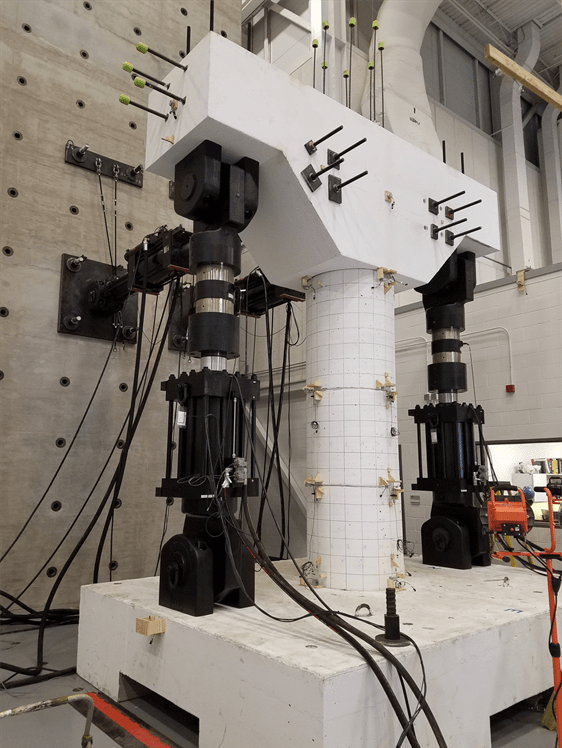Oct 27 2020
For any country, the cost of repairing the structural damage of ailing bridges can be hefty, going up to billions of dollars. New bridge designs ensure more damage-resistant structures and, thus, lower restoration costs.
 Specimen of the hybrid sliding-rocking bridge column tested in the Center for Infrastructure Renewal’s large-scale experimental facilities. Image Credit: Justin Baetge.
Specimen of the hybrid sliding-rocking bridge column tested in the Center for Infrastructure Renewal’s large-scale experimental facilities. Image Credit: Justin Baetge.
However, if these designs were not applied in the real world, it would be hard to estimate their damage possibility and what repair methods should be executed.
Researchers from Texas A&M University and the University of Colorado, Boulder have carried out a detailed damage and repair assessment of a still-to-be-employed bridge design with the help of a group of specialists from industry and academia. The study findings have been reported in the Journal of Structural Engineering.
The team said the expert feedback technique provides a unique and strong method for assessing the viability of bridge designs that are still at a preliminary research and development stage.
Bridges, particularly those in high-seismic regions, are vulnerable to damage and will need repairs at some point. But now the question is what kind of repairs should be used for different types and levels of damage, what will be the cost of these repairs and how long will the repairs take—these are all unknowns for new bridge designs.
Dr Petros Sideris, Assistant Professor, Zachry Department of Civil and Environmental Engineering, Texas A&M University
“We have answered these questions for a novel bridge design using an approach that is seldomly used in structural engineering,” added Dr. Sideris.
A majority of bridges are monolithic structures built by pouring concrete over forms that provide the bridges their shape. These bridges are sufficiently robust to support not only their own weight but also other loads, such as traffic. But according to Sideris, if there is an unanticipated occurrence of seismic motion, these structures are likely to crack, and rectifying the damage would be prohibitively expensive.
To solve these challenges, Sideris and his colleagues have come up with a new design known as a hybrid sliding-rocking bridge. Rather than using a monolithic structure, these bridges would be made of columns with limb-inspired joints and segments.
Thus, if an earthquake occurs, the joints allow a certain amount of the energy from the ground motion to diffuse while there is a slight movement of the segments, where they slide over one another rather than cracking or bending.
Regardless of the total appeal of the hybrid sliding-rocking bridge design, not much is known about how the bridges will act in real-world conditions.
To find the correct repair strategy, we need to know what the damages look like. Our bridge design is relatively new and so there is little scientific literature that we could refer to. And so, we took an unconventional approach to fill our gap in knowledge by recruiting a panel of experts in bridge damage and repair.
Dr Petros Sideris, Assistant Professor, Zachry Department of Civil and Environmental Engineering, Texas A&M University
For their research, Sideris, Dr. Abbie Liel, professor at the University of Colorado, Boulder, and their team employed a group of eight specialists from academia and industry to establish the damage states in experimentally analyzed hybrid sliding-rocking segment engineered columns. Based on their evaluations of the observed damage, the specialist group offered repair plans and estimated costs for repair.
Then, the team applied that information to rectify the broken columns, retested the columns under the same preliminary damage-causing settings, and compared the repaired column’s behavior to that of the original column using computational analyses.
The specialist group learned that columns constructed with their design sustained less damage, on the whole than bridges constructed with traditional designs. The columns exhibited very mild damage even when exposed to motions equivalent to a strong once-in-a-few-thousand-years earthquake.
Moreover, the damage could be rectified comparatively quickly with carbon fibers and grout, indicating that no exclusive strategy was needed for restoration.
Fixing bridges is a slow process and costs a significant amount of money, which then indirectly affects the community. Novel bridge designs that may have a bigger initial cost for construction can be more beneficial in the long run because they are sturdier. The money saved can then be used for helping the community rather than repairing infrastructure.
Dr Petros Sideris, Assistant Professor, Zachry Department of Civil and Environmental Engineering, Texas A&M University
The National Science Foundation funded this research.
Other contributors to this study are Dr. Jakub Valigura, former graduate student researcher from the University of Colorado, Boulder, and Dr. Mohammad Salehi, former graduate student in the civil and environmental engineering department at Texas A&M.
Journal Reference:
Valigura, J., et al. (2020) Seismic Repair Assessment of Hybrid Sliding-Rocking Bridge Columns through Integrated Experimentation and Expert Panel Solicitation. Journal of Structural Engineering. doi.org/10.1061/(ASCE)ST.1943-541X.0002776.